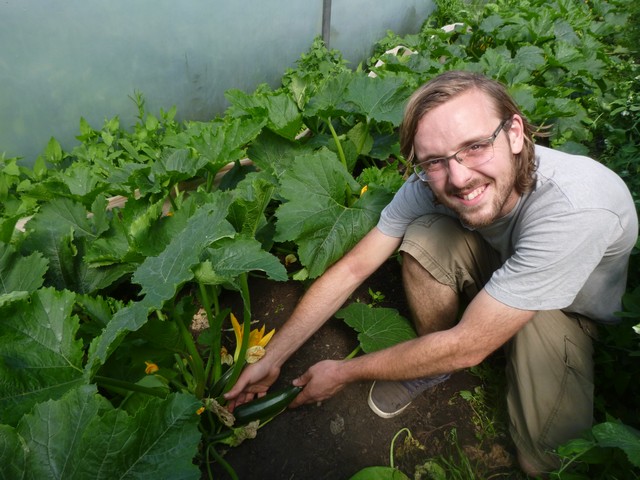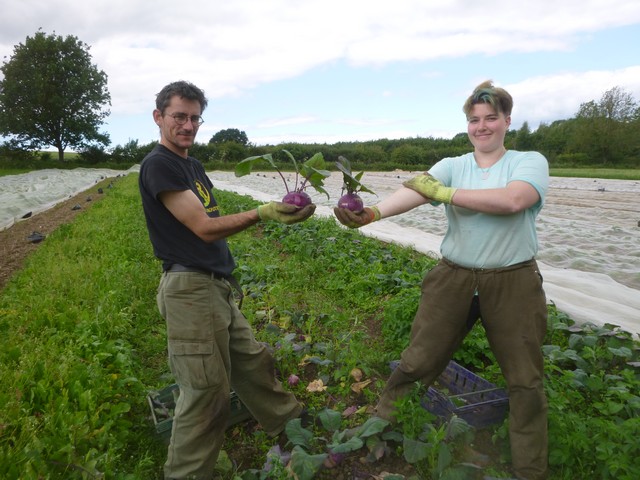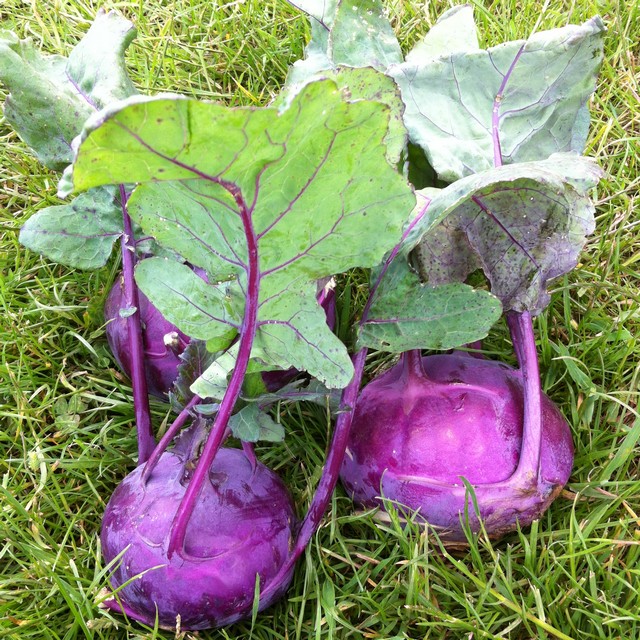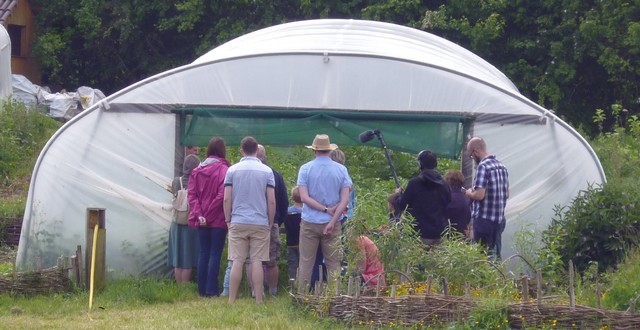Rebecca’s Recipe of the Week: A Warm Salad of French Beans with Gingery Noodles
Warm Japanese noodles and bright green vegetables, tossed with a sharp, gingery dressing make a quick and delicious dinner. The whole thing comes together in under 25 minutes. I think you could add some toasted, chopped peanuts to the top, as well.
The dressing is also very good tossed onto shredded cabbage and kohlrabi, for a punchy slaw.
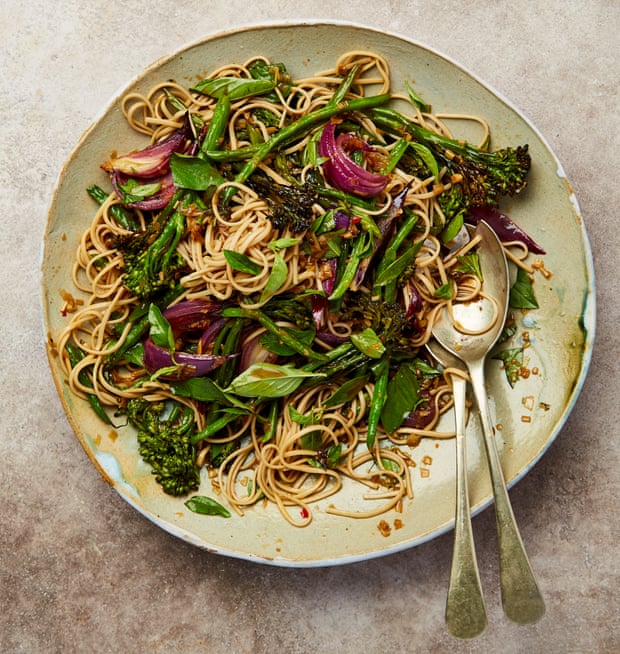
Charred broccoli and bean soba noodle salad
Serves 2
Ingredients
For the salad
450g French beans and/or broccoli (any combination)
2 red onions, peeled and cut into 8 wedges
2 tbsp rapeseed oil
¼ tsp salt
200g soba noodles, or a mixture of soba and udon noodles
¼ cup Thai basil and/or mint leaves, roughly chopped
For the dressing
4 spring onions (use the whole thing), finely chopped
4cm piece fresh ginger, peeled and finely grated
3 tbsp toasted sesame oil
3 tbsp rice wine vinegar (Meera Sodha specifies black Chingkiang vinegar)
4 tbsp light soy sauce
1 tbsp brown rice (or maple) syrup
1 dried red chilli, finely chopped, or de-seeded and then left whole if you’d like the option of removing it later
Preparation
Pre-heat the oven to 220C.
Trim the broccoli into long, slender strips. You can include the green leaves if you like, as well. Top and tail the beans.
Place the broccoli and/or beans and onion wedges on a baking tray. Drizzle over the oil and sprinkle with salt. Mix with your hands, and roast for 10-20 minutes, until they are a bit charred and the leaves have become crispy.
Bring a large pan of water to a boil, then cook the noodles according to packet instructions. Drain and rinse under cold water, then leave to one side to drain.
For the dressing, put all the ingredients in a small saucepan, bring to a boil, then take off the heat and put to one side.
When the vegetables have cooked, tip them into a serving bowl, add the drained noodles and dressing, and toss. Toss in the herbs, and serve while the vegetables are still a little warm.
Recipe adapted from Meera Sodha, The Guardian, 22 June 2019.
2019 – July news: Friends at Five Acre
Canalside featured in the podcast ‘Tales from Five Acre Community Farm’, when Becca and Esther from our sister farm came to Canalside to chat to staff and members. You can listen to it here.

Then later in the same week, a small group of Canalside members paid a visit to Five Acre for a tour with Becca, the grower there.
Rob’s Recipe of the Week: An Alternative to Stir Fry for Onion
We’ve been getting spring onions in the share for a few weeks now, so I thought I would try something different to the usual stir fries and salads… The recipe this week is for spring onion dip! This should go well with courgette sticks, chips (oven baked from the new potatoes) and even fennel. Enjoy best served straight from the fridge, preferably after having a couple of days for the flavours to intensify.
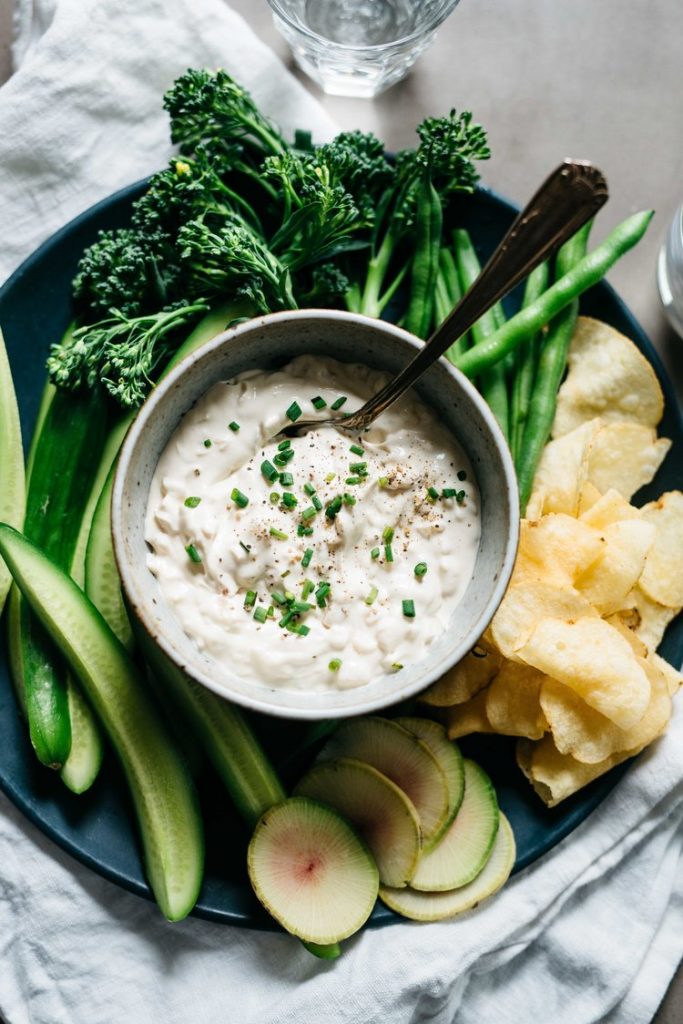
Spring onion dip
Ingredients:
3 tablespoons extra virgin olive oil
1 1/2 cups chopped spring onions
1 1/2 cups raw cashews, soaked overnight or at least 2 hours
fine sea salt
1/2 cup cream cheese (Tesco and Sainsburys both do good vegan alternatives)
1 tablespoon lemon juice
1 1/2 teaspoons apple cider vinegar
1 teaspoon tamari
1/4 teaspoon garlic powder
1/3 cup water, plus more if necessary
chives, for garnish
Method:
Heat a large pan over medium heat. Add 2 tablespoons of olive oil, the onion and a few pinches of salt then stir. Caramelise the onions over 10-12 minutes (stirring occasionally) then transfer to a plate and let cool
Meanwhile, add the cashews, cream cheese, lemon juice, vinegar, tamari, garlic powder, water and 1/2 teaspoon salt to the container of an upright blender (preferably high-speed). Blend on high, scraping down the sides until the dip is smooth and creamy
Taste and adjust the salt and/or lemon juice, as needed
Pour the dip into a bowl, and fold in the onions
Transfer to an airtight container and refrigerate for at least 3 hours, or overnight to really develop the onion flavor.
Rebecca’s Recipe of the Week: Spaghetti with Broad Beans and Marjoram
This immensely straightforward pasta dish demonstrates the results that can be achieved with very simple ingredients. The combination of fresh herbs, crunchy breadcrumbs and slippery, dark-green broad beans is delicious. A glass of rose or a pinot noir would be a very nice accompaniment.
Slipping the broad beans out of their little skins is a bit of a bother, but makes all the difference in the world to the delicacy of the finished dish. I imagine this would work very well with frozen broad beans, as well.
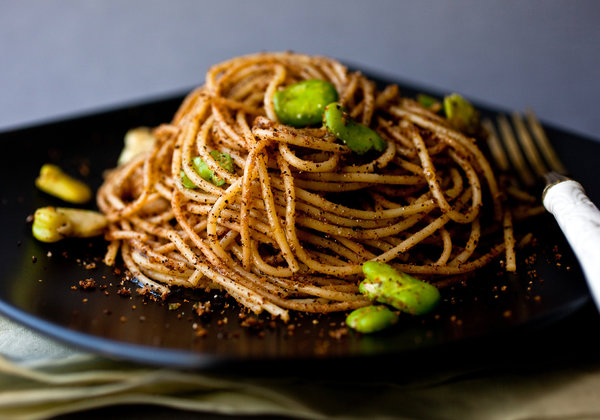
Spaghetti with Broad Beans and Marjoram
Serves 3-4
Ingredients
1kg broad beans, shelled
Salt
300g spaghetti
2 tablespoons olive oil
½ cup fresh bread crumbs, preferably whole wheat
3-4 tablespoons fresh marjoram leaves (to taste), roughly chopped
Freshly ground black pepper
Freshly grated Parmesan or pecorino (or a combination), for serving
Preparation
Bring a large pot of water to a rolling boil over high heat. Add the broad beans and cook for about 5 minutes, or until tender. Drain them, or, if you like, you can scoop the beans out of the water with a slotted spoon. This way you can use the same water to cook the pasta. Whichever approach you take, once the beans are out of the pan run them under some cold water to cool them down a little. Once they’re cool enough to handle, pop them out of their little papery skins.
Bring some more water to the boil, or use the same water. Salt generously, and then add the spaghetti. Cook over high heat, stirring occasionally so the pasta doesn’t stick together, until al dente, about 10 minutes.
Meanwhile, in a small skillet, heat the olive oil over medium heat, then add the bread crumbs, marjoram, salt and pepper. Cook, stirring, until crispy, three to four minutes. Turn off the heat, and set aside.
When the pasta is cooked al dente, remove ½ cup of the cooking water and then drain the pasta. Return the pasta to the pan, and add the broad beans and the cooking water. Return the pan to the heat and cook, stirring, for a minute or two, until the water is absorbed and the beans are warm. Stir in the bread crumb mixture and serve, passing the cheese at the table.
Recipe adapted from New York Times Cooking.
Rob’s Recipe of the Week: Beet and Kohlrabi soup
Welcome to Rob Liddle – the new addition to the weekly update, meaning we now have a recipe creator team!
Rob says: Next week’s share contains beetroot and kohlrabi, so I’ve chosen the soup recipe below (I’ve been looking for something new for lunches for a while!). The recipe makes 4 servings but can be scaled to suit share sizes.
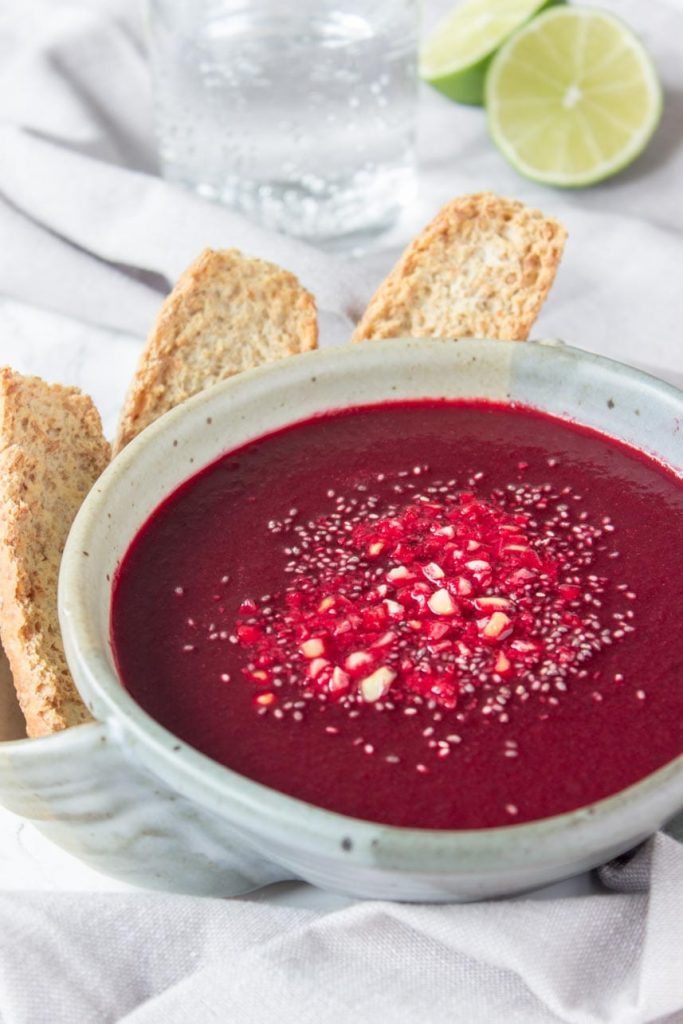
Ingredients
4 small-medium red beetroots diced (0.5cm pieces)
2 medium kohlrabi diced (0.5cm pieces)
1cm fresh ginger (peeled)
4 cups (~1L) water
1 teaspoon cinnamon powder
1 teaspoon turmeric powder
1/2 teaspoon ground cumin
1/4 teaspoon cayenne pepper
Pinch of ground cardamom
Salt to taste
Dash of lime juice to taste
2 tablespoons olive oil
Instructions
Put beetroot, kohlrabi, ginger, and water in a large pot. Bring to a boil over medium heat and then reduce heat to low. Cover and simmer for 25-30 minutes, until beets are fork tender.
Transfer soup to a blender. Add spices and lime juice. Purée on high until creamy and smooth. Return soup back to the pot. Add more water if soup is too thick.
Add olive oil and stir. Taste and adjust seasonings as needed, adding more salt to taste.
Serve hot or cold topped with some chia seeds, and chopped toasted peanuts.
Recipe and photo taken from: https://www.natalieshealth.com/beet-kohlrabi-soup/
2019 – June news: Old King Kohl(rabi)
It’s that time of the year when the words “I’m just not sure what to do with it” reverberate around the collection space: the first kohlrabi share of the year. The first piece of advice is to ask a German, as our central European friends adore this bizarre vegetable; otherwise enjoy it raw, grated in a ‘slaw or cut as batons like carrot sticks, perhaps with a dip. Alternatively you can thinly slice it for a stir fry or steam together with perhaps squash or carrot. It also works well in a stew. Lexicographically, the name means ‘cabbage turnip’, and botanically, it is the swollen stem of the plant, analagous to the stem part of a head of broccoli.
Rebecca’s Recipe of the Week: Carrots with Pickled Raisins
Pickled raisins are very now, in case you didn’t know. This is a very good salad, in any case.
Carrot Salad with Yoghurt, Pickled Raisins and Nuts
Serves 2
Ingredients
2 tablespoons soft brown sugar (dark or light, as you prefer)
2 tablespoons apple cider vinegar
1 handful raisins (or sultanas)
200g carrots, peeled
1 tablespoon olive oil
Salt and pepper, to taste
2 tablespoons preserved lemon, chopped
1 handful pistachios or cashews, toasted briefly in a dry pan and roughly chopped
1 handful fresh coriander (or other herbs), roughly chopped
3 tablespoons yoghurt
Preparation
Combine the sugar and vinegar in a small bowl. Add the raisins and leave to soak for at least 10 minutes, or as long as you like. (I marinated mine for 4 days, at room temperature.) These are the pickled raisins.
Using a vegetable peeler, shave the carrots into thin curls into a bowl, or grate them coarsely.
Dress the carrots with the oil, salt and pepper, and preserved lemon. Mix in the raisins and soaking liquid, nuts, and herbs. Drizzle with the yoghurt and serve.
Recipe adapted from Abra Berens, Ruffage: A Practical Guide to Vegetables (2019).
Summer party 2019 – tickets now on sale!
Tickets are now available to buy:
Through this website – click here.
In Gaia, 7 Regent Place, Leamington Spa. Please ask whoever is at the till.
£7 for anyone 16yrs or over who isn’t a Canalside member, £5 for anyone 16yrs or over who is a member. Under 16s get in free!
Open day at the farm on 9th June 2019 for Open Farm Sunday
Come and visit the farm for a tour with our head grower and a picnic (bring your own) this coming Sunday! The gates of our farm will be open between 11am and 3.30pm.
- Find out about Canalside Community Food
- Have a tour of the vegetable fields and fruit orchard – tours start at 11.30am and 2pm
- Speak to staff and members
- Bring a picnic to enjoy in our family friendly social area

2019 – May news: Three firsts in one day
On Tuesday of this week we were delighted to pick 3 new crops on the same day: the first courgette, sugar snap pea and cucumber all made their appearance. As production increases it may be a short while until you see all of these crops in your share but they are certainly on their way!
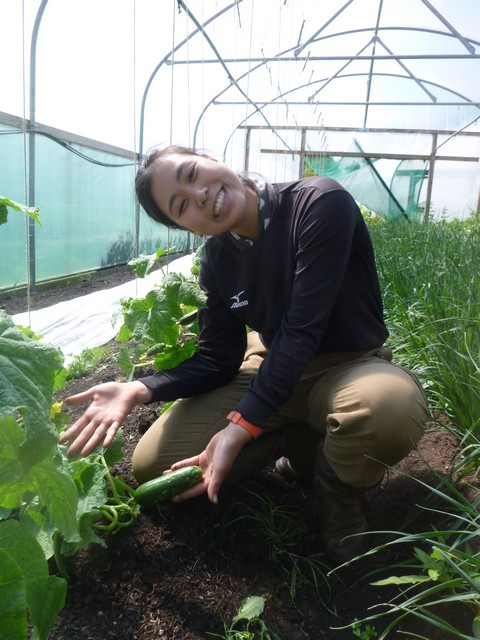
First cucumber 
First sugar snap pea 